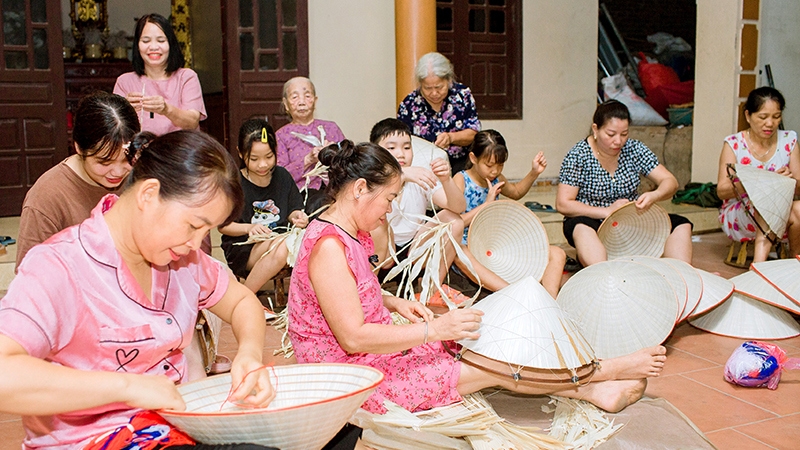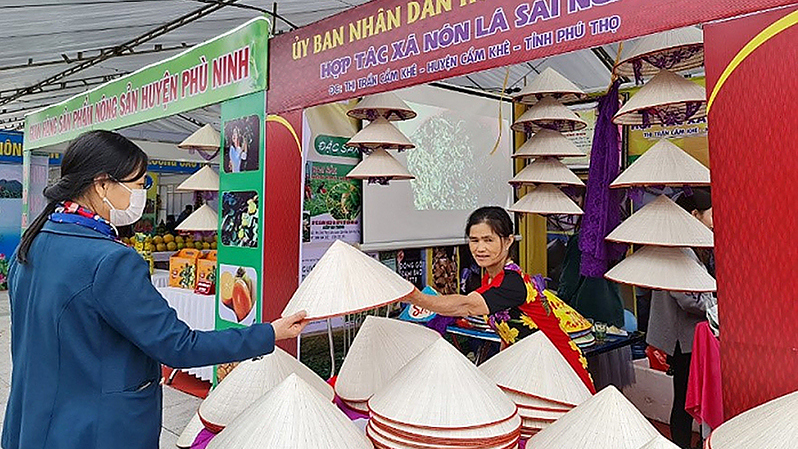In the past few years, delegations visiting the Truong Sa (Spratly) archipelago have often encountered images of women on the islands of Truong Sa, Song Tu Tay and Sinh Ton, with their charming conical hats, waving from the jetty. It was surprising to discover that these are Sai Nga conical hats which were sent as a gift from Cam Khe District (Phu Tho).

Preserving Sai Nga conical hat-making craft
Not only preserving and developing traditional crafts, the people of the northern midland province of Phu Tho also send their love to the remote regions of the country through the rustic and poetic conical hat image.
Struggling to stick to the craft
The seniors in Sai Nga craft village said that the Sai Nga conical hat-making craft appeared in the 1950s, led by a group of people from Chuong Village (Thanh Oai, Hanoi) who relocated to the northern midland region. Life in the new land was full of difficulties and hardships, but the households continued to preserve the craft and pass on their experience to their descendants. Along with Sai Nga, the conical hat-making craft is widely developed in the villages of Son Nga, Thanh Nga and Tung Khe in Cam Khe District. While making conical hats, the villagers chant familiar verses.
In the land, female students at primary school can skilfully create conical hats and Sai Nga girls who get married also bring the conical hat-making craft. Previously, more than 90% of households in Sai Nga Commune were making conical hats. Currently, due to the development of industrial zones, the number of households practicing the craft has decreased, but not to the point of absence. Sai Nga still has a conical hat cooperative with nearly 30 member households. Households work, share and support each other in terms of technology, input materials and output products. Every year, the cooperative organises many training sessions on techniques and markets.
Nguyen Thi Thanh Tuyen, Director of Sai Nga Conical Hat Cooperative, said that this year, the Ministry of Culture, Sports and Tourism recognised the Sai Nga conical hat-making craft as a national intangible cultural heritage. That is the pride of the people, and at the same time opens many new development directions for the craft village.
Nearly 70 years old, Nguyen Thi Thao, at Van Phu 3 area, is still making conical hats. The Covid-19 epidemic, market difficulties, did not discourage her. The craft has been with her since childhood, more than 50 years now. In her family, Thao's grandchildren began learning how to make conical hats from a very young age, studying and taking advantage of their free time to help the family. Thao shared that, if the work is regular, a worker can earn about VND4 million to VND 5 million each month, enough to cover daily living expenses.
A perfect conical hat needs to go through many meticulous stages. Materials for making conical hats include: leaves, a wooden frame, a conical ring, silk thread, and tools to flatten the leaves. With enough materials, people just start each stage. Leaves for making conical hats are purchased from many regions and sold at the village market. It takes about three hours to complete a conical hat, however in order to make the finished product more beautiful, it is necessary to be treated with brimstone and decorate it with floral patterns between two layers of thin leaves. A beautiful hat must be round, balanced and bright white, with even sewing lines, and a smooth surface.
Sai Nga people mainly make two types: "ky" conical hat and "thua" conical hat. A "ky" conical hat is a type of conical hat with carefully selected materials, inside is lined with nylon, decorated with flowers or beautiful images of the homeland or country. The conical hat is finally finished with a layer of oil to improve durability and waterproofing. The top of conical hat is carefully stitched. This type of conical hat costs from VND55,000 to VND100,000 per piece.
The "thua" conical hat is a type with fewer stages, thinner and simpler, sold to small traders from VND 20,000 to VND 50,000 each, mainly consumed in tourism and export.
On average, each year, Sai Nga Village produces more than 600,000 conical hats, earning tens of billions of dong. Most of the products, meeting the quality requirements, are purchased by traders on the spot. From the past until now, Sai Nga people have preserved the tradition of bringing conical hats to the markets to sell as a unique cultural feature.
Sai Nga market mainly trades and sells conical hats and conical hat-making materials such as: leaves, freight, wool, the conical ring, conical flowers.
In addition to the export volume, Sai Nga conical hats also appear widely in the provinces of Lao Cai and Yen Bai and Thai Nguyen, especially at trade fairs and the Hung Kings Temple Festival. Thanks to their persistence in preserving their craft, local people's lives have been improved markedly.

People see Sai Nga conical hat products at a fair to promote and connect OCOP products in Phu Tho Province in 2020. Photo: Nguyen Lien
Access to modern technology
Sai Nga conical hat-making craft is recognised as a national intangible cultural heritage, both a pride and affirmation of its position from being a side craft to becoming the main highlight, promising great prosperity and change.
Bui Xuan Vinh, Standing Deputy Secretary of the Cam Khe District Party Committee, shared that in the coming time, the district's Department of Agriculture and Rural Development will coordinate with related sectors to deploy modern machinery to reduce labour for people, who are doing the craft.
In addition, once the Covid-19 epidemic situation is under control, the district will also organise for representatives of craft villages who are skilled and reputable long-time producers in their village along with leaders of the craft villages to visit and exchange experiences with other localities.
Besides, Cam Khe District will focus on developing and promoting Sai Nga conical hat brand not only in the province but nationwide and internationally. Currently, all levels and sectors from provinces to districts and communes are interested in investing in building display houses, promoting products associated with craft village tourism, the journey of Xoan singing heritage and the worship rituals of the Hung Kings.
Facing many challenges in terms of conservation and development, the locality is focusing on developing craft village infrastructure to better serve the demands of craft village tourism.
With the advantage of Noi Bai - Lao Cai Highway running through Cam Khe area, the locality has a plan to build a centre to display and introduce products; a concentrated production area, eligible to become attractions for tourists. Vocational training; mechanisms and policies to encourage good artisans and workers; organisation of skills contests, conferring titles of artisans and good workers; and investment in building and developing markets and product brands are the main goals of the locality in the coming time.
In the past two years, due to the impact of COVID-19 pandemic, Sai Nga conical hat-making craft faced many difficulties from input materials to output consumption for products. However, with constant efforts, local people have approached social networks, applied the form of online product introduction, online sales. Information technology has covered Sai Nga, many elderly people are proficient in using smartphones, taking photos, livestreaming to promote and sell online. In particular, in the past few years, Sai Nga Commune has often actively contributed to meaningful social activities.
The rustic conical hat containing the love of the midland has brought to the jetty in Truong Sa Island District a deep charm; softening the harsh sun in the Cam Ranh urban area, when the wives and mothers alone take care of the family and children all year round, making a solid rear for the soldiers to work confidently.
Although there are still many troubles and hardships, Sai Nga conical hat-making craft is still quietly, persistently spreading and developing with the will to rise up, integrating sustainably with the progress of socio-cultural life.
Mai Lu